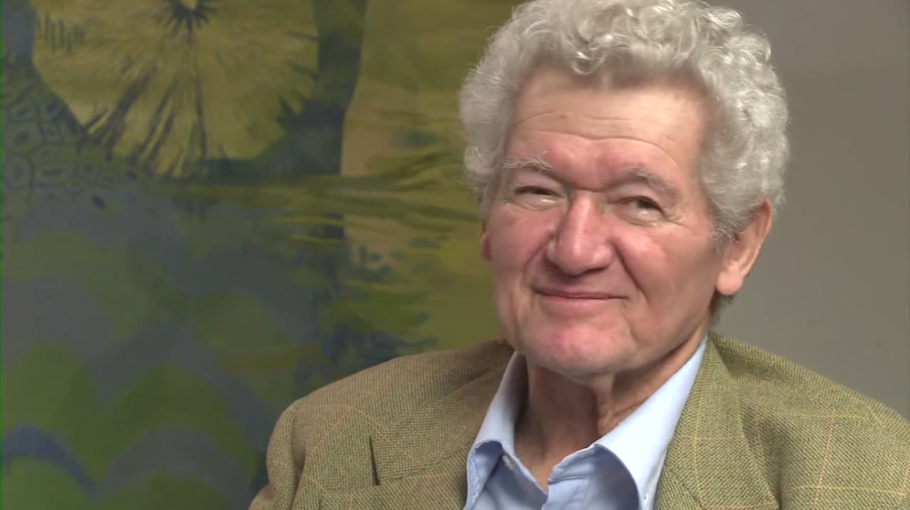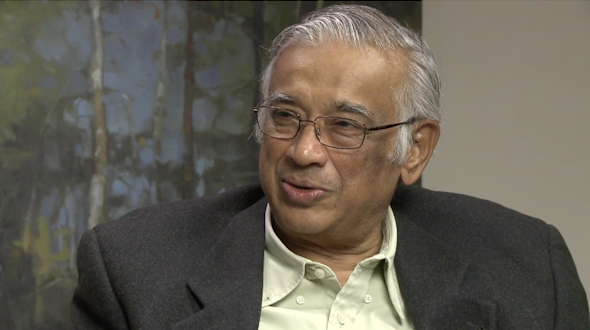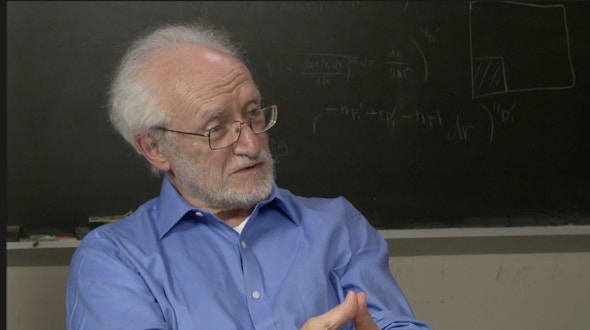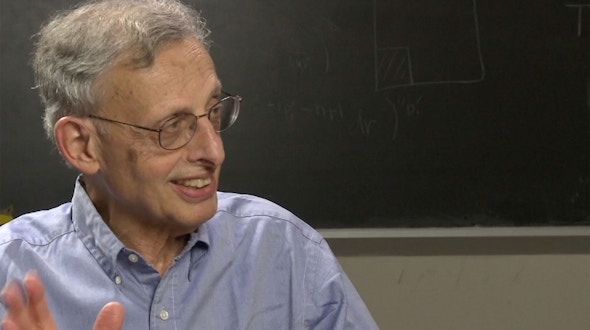Peter Lax
- Highlights (3:57)
- Inclination Toward Mathematics (6:01)
- Budapest to New York in 1941 (3:36)
- Arrival in America and Meeting Courant (2:20)
- Stuyvesant High School (1:23)
- Meeting Anneli, Military Service and Los Alamos (3:28)
- Experiences at Los Alamos (5:37)
- Szegő and Erdős (2:52)
- Dissertation (2:30)
- Influence of Friedrichs (2:28)
- Von Neumann and the Beginning of Modern Computing (3:20)
- Computing in 1949 (1:46)
- Serving on the National Science Board (3:25)
- Impact of the Internet on Science (2:31)
- Marriage to Anneli Cahn and Her Work (4:52)
- The Empty Bed (1:05)
- Mathematics Research During the Cold War (1:53)
- Lax-Milgram Theorem (1:32)
- Propagation of Singularities (6:02)
- Collaboration with Ralph Phillips (1:44)
- The Book with Ralph Phillips (3:14)
- Collaboration with Nirenberg (1:00)
- Sloan and Courant (2:36)
- Warren Weaver and Courant (3:29)
- Environment at Courant (3:34)
- Expanding CIMS in the 1970s (2:21)
- Solitary Waves and Lax Pairs (4:24)
- Influence of Von Neumann's Early Work (1:56)
- Pure vs. Applied Mathematics (1:13)
- Textbooks (6:59)
- NYU Computer Center Takeover in 1970 (2:26)
- House at Loon Lake (4:04)
- The Influence of Technology on Mathematics (3:15)
- Cohen, Friedrichs and difficult problems (4:04)
- Prizes (1:33)
- The Hungarian Tradition of Elegance (2:34)
- The Future of Mathematics (1:54)
- Impressions of Paul Erdős and Kakutani (5:11)
- Von Neumann's Style (3:20)
- Kirchhoff's Laws and the Euler Characteristic (2:32)
- Grateful to the Math Community (0:38)
Peter Lax’s mathematical work is a harmonious combination of pure and applied: an elegant geometric, functional-analytic style of attacking hard problems in physics and in practical computing. “I like to start with some phenomenon, the more striking the better, and then use mathematics to try to understand it,” he said. “The formation, propagation, interaction, decay of shock waves, is an example of a striking phenomenon. So is the scattering of electromagnetic and acoustic waves. So is the stability and coherence of solitary waves, governed by completely integrable equations. So is the weak but not strong convergence of oscillating solutions of dispersive systems.”
Born in 1926 in Budapest, he was early recognized as a mathematical prodigy. Lax’s father Henry and his mother Klara were both physicians. They provided him with a wonderful tutor, Rozsa Peter (born Politzer), who later would become recognized both as a founder of the theory of recursive functions, and as author of the classic expository book, Playing with Infinity. As a Jew and a woman, she was then ineligible for university employment. “The very first thing we did,” Lax recalled, “was to read The Enjoyment of Mathematics by Rademacher and Töplitz. I was twelve or thirteen.… I went to her house twice a week for a period of a couple of years — until I left Hungary at fifteen and a half.”
The limited toleration which Hungarian Jews had enjoyed in Lax’s early childhood evaporated with the onset of the Second Great War. A Hitlerite political party, “Arrow Cross,” grew powerful. For a while people consoled themselves, thinking that if Budapest became too uncomfortable, they could move to Paris. But in May 1940, Hitler struck through Holland and Belgium, and France fell in a few days. All of Europe was falling under the madman Hitler.
It was not very simple to escape across the Atlantic. The Laxes could manage the expense, but it was hard to run away from a prestigious, well-established personal and professional life. Peter’s mother insisted that they go before it was too late. They left Lisbon on the last American boat to make the trip to the U.S. Two days later Japan bombed Pearl Harbor. Britain declared war on Hungary and Hungary declared war on the United States. Lax and his family would initially be classified as “enemy aliens.”
When they arrived in New York, they contacted Gabor Szegö, the chairman of the math department at Stanford, whom they knew well because his wife was a cousin of Lax’s mother. Szego suggested that Lax work with Richard Courant at New York University, saying that Courant was known to be exceptionally good with young people.
Lax enrolled in Stuyvesant High, a selective science-oriented school with a competitive math team. He was already far beyond their math teachers. But he did enjoy learning American history. It was great to find his history book illustrated with humorous cartoons so different from how national history was portrayed in Hungary.
After a year at Stuyvesant, Lax started at N.Y.U., where he has remained ever since (with interludes at Los Alamos, Stanford and elsewhere.) He was drafted into the U.S. Army and became a corporal at the Los Alamos Manhattan Project in New Mexico. He said, “The first time I spent in Los Alamos, and especially the later exposure, shaped my mathematical thinking. First of all, it was the experience of being part of a scientific team — not just of mathematicians, but people with different outlooks — with the aim being, not a theorem, but a product. One cannot learn that from books, one must be a participant. Secondly, it was there — that was in the 1950s — that I became imbued with the utter importance of computing for science and mathematics… In 1952 I started to make my experiments on shock capturing. I remember writing machine code for the MANIAC (the machine Von Neumann built and started using in 1951). Later on I used assembly language, but still pre-Fortran.”
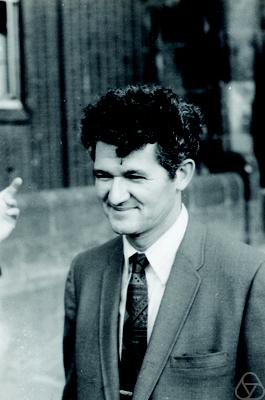
Returning from New Mexico to graduate school in New York, in a class on complex variables he met his brilliant and beautiful future bride Anneli Cahn. He wrote a thesis under Courant’s student Kurt Otto Friedrichs, in partial differential equations (PDE), which would be his lifelong mathematical milieu. In 1951 he was appointed assistant professor at N.Y.U. According to the Mathematics Genealogy Project, Lax by now has had 55 doctoral students and 430 doctoral descendants.
In 1970 a group calling itself the Transcendental Students held the Courant Institute’s CDC 6600 computer hostage, demanding $100,000 bail money for the Black Panthers. Lax had been instrumental in acquiring the machine. After 48 hours the occupiers left. Lax recalled: “I could smell smoke, so we said, ‘Let’s go in, some damage could come to the machine.’” They found a home-made fuse burning. “Two of my younger colleagues jumped in and stepped on it, while the rest of us went to the machine room and removed the flammable liquids that were hung on the machine,” he said. “And so the 6600 was saved.”
When Anneli asked Lax if he was crazy going in there, he answered, “Honestly, I was so mad I didn’t think. I wasn’t thinking.”
Two years later, in 1972, he became director of the Courant Institute, and served until 1980. From 1980 to 1986 he was on the National Science Board. “Supercomputers” were then available only to military and industrial centers, not to universities. Lax chaired a panel whose recommendations to the National Science Foundation resulted in the establishment of five national computing centers.
In 1978, tragedy struck, when Lax’s oldest son, John, a brilliant graduate student in history at Columbia University, was killed by a drunken driver. He was 27 years old. In 1992 Anneli retired from her positions as professor at N.Y.U. and editor of the New Mathematical Library. In 1997 Anneli was diagnosed with cancer, by her younger son, Jimmy, who had become a physician like his grandfather. She lived for two years. Lax’s second wife, Lori, is a musician and the daughter of Richard Courant.
With a small number of outstanding exceptions, the worlds of “pure” and “applied” mathematics are usually distinct. The “pure” values above all, rigor and clarity; the “applied” values above all, relevance and utility. Peter Lax is almost unique in his mastery of both abstract analysis and practical computing. His deep insights from abstract analysis enlighten and advance the practical computing of real physical problems.
As a general rule, if you want more than qualitative information about a PDE, especially a nonlinear one, your only hope is to approximate it. Of course, the point is to approximate it with equations you can solve — with algebraic equations whose solutions can be “written down” recursively. The “Lax-Richtmyer theorem” virtually revolutionized theoretical numerical analysis of partial differential equations of evolution, even though it is merely a direct application of the elements of functional analysis. People had assumed that determining whether a difference approximation to a PDE is “convergent” and whether it’s “stable” are two different problems. Lax and Bob Richtmyer noticed and proved that they are actually the same problem.
The “Lax-Wendroff” method is one of Lax’s most popular contributions (with Burt Wendroff of Los Alamos.) It is used to compute shock waves, which is a challenging mathematical problem. Here Lax contributed his famous entropy condition, which gives the physically correct continuation of the wave across the shock discontinuity. And, again amazingly, he contributed, in an important special case, actually a new explicit solution!
One of Lax’s most referenced papers is “Asymptotic solutions of oscillatory initial value problems.” This rather concrete, classical paper, on a seemingly rather special subject, has reverberated over the decades through general theories of the “Fourier integral operator calculus” developed by Lars Hörmander and his followers. Lax explained, “It is a micro-local description of what is going on. It combines looking at the problem in the large and in the small. It combines both aspects, and that gives it its strength.”
Equally or more influential has been his work on “solitons” — solutions of nonlinear PDE’s that (totally unexpectedly) describing moving waves that preserve their form after undergoing mutual collisions. These were discovered, in the case of the Korteweg-de Vries equation, by Martin Kruskal and Norman Zabusky. As time tends to infinity, each soliton preserves its shape, so in a sense they’re like particles.
Lax introduced a pair of non-commuting linear operators L and P to rewrite this equation in the form:
dL/dt = PL – LP
which is now called “the Lax equation.” There was a lot of excitement when it turned out that a large number of other nonlinear partial differential equations of physics can be written in the form of the Lax equation, which meant that they have soliton solutions, and can be solved by the method that Kruskal and his collaborators had found for Korteweg-de Vries.
Lax’s work on scattering theory, in collaboration with Ralph Phillips, he calls “one of the great pleasures of my life.” Heisenberg’s scattering theory is an input-output approach to collisions in quantum mechanics. The “scattering operator” transforms an incoming wave into an outgoing wave. This general formulation applies to light waves and sound waves just as well as to collisions of elementary particles. In the hands of Lax and Phillips, it became a beautiful new topic in functional analysis. An amazing, totally unexpected connection of Lax-Phillips scattering theory to number theory, by way of non-Euclidean geometry, was discovered by the Russian mathematicians Ludwig Faddeev and Boris Pavlov. By following the Faddeev-Pavlov discovery, “We were even able to contemplate the Riemann hypothesis peeking around the corner.” The Riemann hypothesis, the outstanding open problem in mathematics, is equivalent to a certain estimate, also still unproved, that occurs in the non-Euclidean version of the Lax-Phillips scattering theory.
Peter Lax has written two books on scattering theory (co-authored with Ralph Phillips), two books on hyperbolic partial differential equations, and textbooks on linear algebra, functional analysis, and calculus. He has been elected to ten Academies of Science, and has won many prizes and medals, most recently the Abel Prize of Norway.
